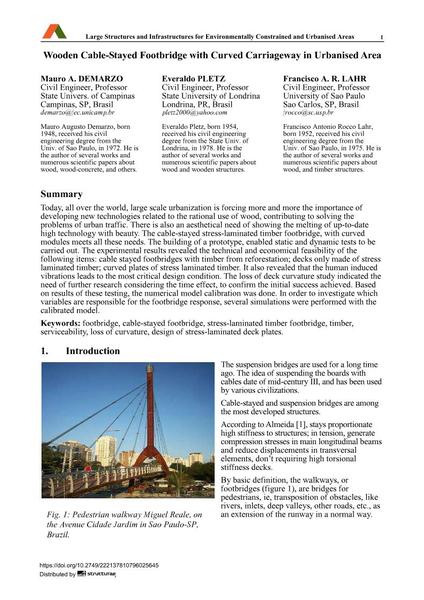Wooden Cable-Stayed Footbridge with Curved Carriageway in Urbanised Area

|
|
|||||||||||
Bibliographic Details
| Author(s): |
Mauro A. Demarzo
Everaldo Pletz Francisco A. R. Lahr |
||||
|---|---|---|---|---|---|
| Medium: | conference paper | ||||
| Language(s): | English | ||||
| Conference: | IABSE Symposium: Large Structures and Infrastructures for Environmentally Constrained and Urbanised Areas, Venice, Italy, 22-24 September 2010 | ||||
| Published in: | IABSE Symposium Venice 2010 | ||||
|
|||||
| Page(s): | 534-535 | ||||
| Total no. of pages: | 8 | ||||
| Year: | 2010 | ||||
| DOI: | 10.2749/222137810796025645 | ||||
| Abstract: |
Today, all over the world, large scale urbanization is forcing more and more the importance of developing new technologies related to the rational use of wood, contributing to solving the problems of urban traffic. There is also an aesthetical need of showing the melting of up-to-date high technology with beauty. The cable-stayed stress-laminated timber footbridge, with curved modules meets all these needs. The building of a prototype, enabled static and dynamic tests to be carried out. The experimental results revealed the technical and economical feasibility of the following items: cable stayed footbridges with timber from reforestation; decks only made of stress laminated timber; curved plates of stress laminated timber. It also revealed that the human induced vibrations leads to the most critical design condition. The loss of deck curvature study indicated the need of further research considering the time effect, to confirm the initial success achieved. Based on results of these testing, the numerical model calibration was done. In order to investigate which variables are responsible for the footbridge response, several simulations were performed with the calibrated model. |
||||
| Keywords: |
footbridge serviceability timber cable-stayed footbridge stress-laminated timber footbridge loss of curvature design of stress-laminated deck plates
|
||||




